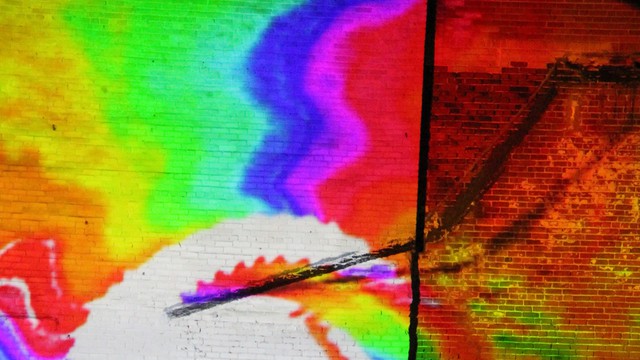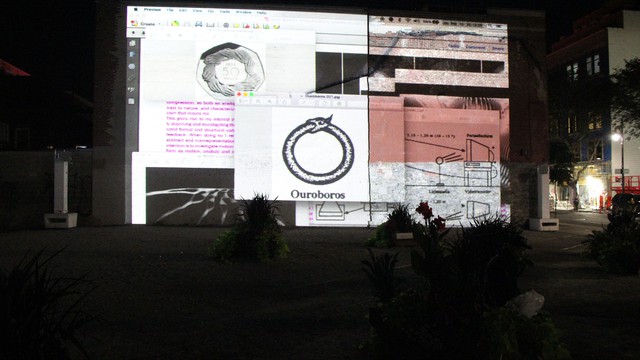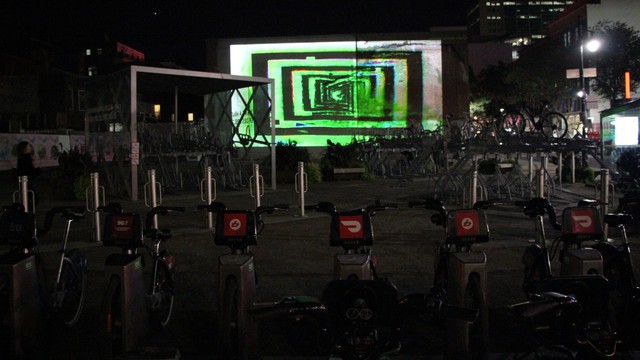Écran de Veille / Screen Savour 2022, Canada, Montreal
A self-surveilling generative feedback installation







Écran de Veille / Screen Savour is a self-surveilling generative projection that twists our understanding of the ‘idle’ screen space, and explores the potential of optical feedback systems as playful interfaces on a grand scale. The installation is adapted to and affected by the site itself; from the texture of the facade to ambient lighting and public activity.
Écran de Veille presents several generative ‘screen savers’ created live through optical video feedback. These colourful evolving patterns are created using a surveillance camera (mounted within the projection cabin) which ‘watches’ the screen, forming a giant ouroboros loop; a screen saver that surveils itself. The generative patterns can also be disrupted by the movement of passers by, echoing their movement like ripples in a pond. Though the technique is as old as video itself (dating back to the 60s) the application of optical video feedback within the public realm is novel, due it its inherent sensitivity and instability. ‘Screen Savour’ utilises digital video processing and projection mapping to calibrate the system. The work is very probably the largest sustained optical video feedback loop ever created. The ‘screen savers’ are interrupted by micro-documentaries that play with our understanding of who is controlling the screen. Five short scenes appear to show a remote computer desktop, as the user navigates though a bizarre collection of research: texts on chaos theory and ‘strange loops’, images of geckos shedding skin and snakes eating their tails, jigsaws of jigsaws of jigsaws, and even a live feed of the projection site ítself. Does this person know we can see their screen? Or perhaps they can see us? Who is watching who? Is this whole installation simply a giant desktop screen saver? The work also employs a generative and reactive sound design by Tom Rea Smith, which is in turn affected by changes in the visual behaviour of the installation and camera tracking of passers by.
http://documents.smeech.co.uk/2023-ScreenSavour-techdoc.pdf
Details
Building or project owner : Quartier des Spectacles - managers of site
Project artist/ concept/ design/ planning : Sam Meech
Display content/ visuals/ showreel : Sam Meech - video / Tom Rea Smith - Sound
Lighting control software : Isadora by Troikatronix
Project co-ordination : Yolène Le Roux / Amélie Forget - Quartier des Spectacles
Interaction design/ programming : Sam Meech
Project sponsor/ support : Quartier des Spectacles
Descriptions
Facade type and geometry (structure) : Écran de Veille (Sept 2022) was projected onto the exposed side of a 3 story brick building at the site of métro St Laurent, Montreal. The projection covers the whole areas of the facade, right to ground level. The building is part of a terrace of buildings which house small business (restaurants, army surplus, strip bars). Presumably a neighbouring building has been demolished at some point, leaving the rough brickwork of an interior in profile. The facade is rectangular on a roughly 2:1 ratio (20.5m x 10.25m). The lower right portion of the facade is rough grey stone. The parts of the facade have been painted white, whilst other parts remains red brick and grey stone. The facade is frequently subject to graffiti, which affects the behaviour of the optical feedback system by virtue of changing the colour and texture of the facade.
Kind of light creation : The primary source of light creation is projection, though in theory the system can work with other forms of ‘screen’. Since the work is an optical feedback system, additional methods of light creation or manipulation (ambient lighting, car headlights, phone torches, lasers, shadows etc) will also affect the work. Écran de Veille (Sept 2022) sited at métro St Laurent used a projection system managed by Quartier des Spectacles. The system used two (2) Christie Roadster S+16K projectors, in double convergence, with a 2.6-4.1:1 Zoom lens. The projectors display a 4:3 image in landscape mode.
Resolution and transmitting behaviour : Écran de Veille (Sept 2022) projection used a functional resolution of 1400 x 700 pixels. The resolution of the work can be adapted depending on the site. As the work is an optical feedback system. any changes in the final projected image, the camera input or the video signal will, by definition, affect the behaviour of the feedback, thereby inducing changes in the patterns generated. Similarly, changes in the mode of transmission from camera to projector (cable length, type, quality, capture card, processor speed) will affect the latency of the feedback loop, again, altering the behaviour.
Pixel distance : approx 1.5cm (métro St Laurent projection)
Luminace : stated luminance in the Quartier 16 000 lm however it could well be that these projectors have been in use for a long while.
Urban situation : Metro St Laurent (H2X 1J5) is near the heart of the lively downtown area of Montreal. The projection facade looks onto an open gravel square by a busy crossroads. It also accommodates bicycle parking racks. As such it is transient site for people moving through the city. Any works - which are projected right to ground level - receive a fair amount of acknowledgement and engagement. The building facade is not well maintained, though graffiti is periodically cleared. The square has several benches and planters enabling people to wait for friends whilst enjoying the projections. The area has many homeless people. Later in the evenings people pass through on their way to nightclubs, often drunk. Wooden hoardings run from the facade to the station entrance. It is not uncommon to see people urinate against the wooden hoardings or the projection facade itself.
Description of showreel : The video showreel depicts the 20 minute loop of the installation on site - containing 5 x generative feedback scenes (3 mins each), and 5 x ‘desktop documentaries’ (1 minute each), as well as the commissioners credits.
Participatory architecture & urban interaction
Mediacredits
Sam Meech
Sam Meech
Sam Meech
Sam Meech
Sam Meech
Sam Meech
Sam Meech
Sam Meech